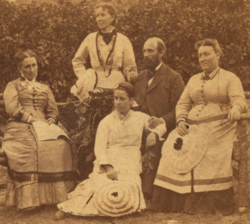| The Late Corporation of the Church of Jesus Christ of Latter-Day Saints v. United States | |
|---|---|
 | |
| Argued January 16–18, 1889 Decided May 19, 1890 | |
| Full case name | The Late Corporation of the Church of Jesus Christ of Latter-Day Saints et al. v. United States; Romney et al. v. United States |
| Citations | 136 U.S. 1 (more) 10 S. Ct. 792; 34 L. Ed. 478; 1890 U.S. LEXIS 2199 |
| Case history | |
| Prior | Edmunds-Tucker Act provisions authorizing disincorporation of LDS Church upheld in U.S. v. Church of Jesus Christ of Latter-Day Saints. 5 Utah 361, 15 P. 473 (Utah.Terr. 1887). Appeal from the Supreme Court of the Utah Territory |
| Holding | |
| Congress has supreme authority over territories, including power to dissolve the LDS Church's corporation and seize its property. Under parens patriae principles, Congress may redirect assets to charitable purposes within Utah Territory. Property was properly not transferred to church members because they were using it to further the outlawed practice of polygamy. | |
| Court membership | |
| |
| Case opinions | |
| Majority | Bradley, joined by Miller, Harlan, Gray, Blatchford, Brewer |
| Dissent | Fuller, joined by Lamar, Field |
| Laws applied | |
| U.S. Const. amend. I; Edmunds-Tucker Act | |
| Mormonism and polygamy |
|---|
 |
|
|
The Late Corporation of the Church of Jesus Christ of Latter-Day Saints v. United States, 136 U.S. 1 (1890), was a Supreme Court case that upheld the Edmunds–Tucker Act on May 19, 1890. Among other things, the act disincorporated the Church of Jesus Christ of Latter-day Saints (LDS Church).
The LDS Church was represented by its chief counsel Franklin S. Richards and former congressman James Broadhead.[1]
YouTube Encyclopedic
-
1/3Views:4241 2254 054
-
Jacob S. Rugh: The Divide in the LDS 2020 Vote.
-
Church Finances: Disconcerting or Miraculous?
-
A Disposition to Do Good Continually | Spencer J. Condie
Transcription
Decision
The ruling in Late Corporation would have directed federal escheat of substantially all the property of the legally disincorporated LDS Church, which was estimated at $3 million. Following the decision, the U.S. Attorney for The Utah Territory reported seizing only $381,812 in assets.[2] Real property, including LDS temples, was never seized, although the ruling authorized it. Within five months, the LDS Church officially discontinued the practice of plural marriage with the 1890 Manifesto. On October 25, 1893, a congressional resolution authorized the release of assets seized from the LDS Church because, "said church has discontinued the practice of polygamy and no longer encourages or gives countenance to any manner of practices in violation of law, or contrary to good morals or public policy."[3]
Chief Justice Fuller's dissent asserted that though Congress has the power to criminalize polygamy, "it is not authorized under the cover of that power to seize and confiscate the property of persons, individuals, or corporations, without office found, because they may have been guilty of criminal practices."[4]
See also
- 1890 Manifesto
- Edmunds Act (1882)
- Edmunds-Tucker Act (1887)
- History of civil marriage in the U.S.
- List of United States Supreme Court cases, volume 136
- Morrill Anti-Bigamy Act (1862)
- Poland Act (1874)
- Reynolds v. United States (1879)
- Second Manifesto (1904)
- Smoot Hearings (1903–1907)
References
- ^ Rothera, Evan (March 2016). "The Tenacious "Twin Relic": Republicans, Polygamy, and The Late Corporation of the Church of Jesus Christ of Latter-Day Saints v. United States". Journal of Supreme Court History. 41: 21–38. doi:10.1111/jsch.12091. S2CID 148549941.
- ^ Paul G. Kauper & Stephen C. Ellis, "Religious Corporations and the Law," 71 Mich. L. Rev. (1972-1973), 1499, 1517. This figure includes seized stock and cash in bank accounts as well as $10,000 "credits due on sheep."
- ^ Jt. Res 11., 53d Cong., 1st Sess., 28 Stat. 980
- ^ 136 U.S. 67 (1890)
Further reading
- "The Manifesto and the End of Plural Marriage", churchofjesuschrist.org, LDS Church, retrieved October 22, 2014
External links
 Works related to Late Corp. of the Church of Jesus Christ of Latter-Day Saints v. United States at Wikisource
Works related to Late Corp. of the Church of Jesus Christ of Latter-Day Saints v. United States at Wikisource- Text of Late Corp. of the Church of Jesus Christ of Latter-Day Saints v. United States, 136 U.S. 1 (1890) is available from: Findlaw Justia Library of Congress
